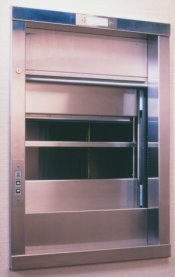Archive for the 'commercial dumbwaiters' Category
Using Commercial Dumbwaiters
Dumbwaiters have been used for thousands of years to help make it easier for goods to be moved between a multi-story structure. Early dumbwaiters utilized animal or people power, which was made easier through the use of a pulley system. Eventually water dumbwaiters were developed, but the first electric dumbwaiter would not be seen until the late nineteenth century.
The nineteenth century was an exciting time for the elevator and the dumbwaiter in America. Many innovations took place during this time, including the first passenger elevator and the first hydraulic elevator. It was also during this time that the first electric dumbwaiter was created. Dumbwaiters had been incredibly popular in America for some time and were found in virtually all buildings and structures that spanned several floors. One of the major downfalls though, was that if the rope or cable supporting the dumbwaiter broke, the dumbwaiter car would fall.
This changed in early 1850’s as Elisha Otis developed several commercial dumbwaiters that were designed to catch themselves instead of falling. By the end of the nineteenth century, most electric dumbwaiters would include safety features that protected it against a sudden fall.
These early commercial dumbwaiters were incredibly popular in New York, which is also the birth place of the modern elevator. Since space was limited in New York, many multi-level buildings, manufacturing plants, and factories, were constructed. These plants needed a way to move their products from one floor to the next, so dumbwaiters were extensively used. While the electrical dumbwaiter was becoming popular, many people still relied on a steam powered dumbwaiter.
Elisha Otis, ever an innovator of the elevator industry, created a special elevator that included its own steam power plant. These became very popular, because it was no longer necessary for buildings to have their own power plant.
Some of the earliest dumbwaiters were used in the production of transportation vehicles. One inventor named Jasper Murtaugh greatly helped to improve the technology that powered the early dumbwaiter. Using a system similar to the one designed by Elisha Otis, Murtaugh created a dumbwaiter for a carriage manufacturer, which could support over two thousand pounds. The Murtaugh dumbwaiter could have all four of its cables cut, while fully loaded, without risk of falling.
People today use dumbwaiters in many settings. They are still popular in residential settings, but less so when compared to the early twentieth century. Many easy to install electric dumbwaiter kits are available today, which has helped increase the popularity of these devices over the past years. They are also commonly added to new homes to help make it more attractive to potential buyers, but they can usually be retro-fit into a home as well.
While dumbwaiters in residential settings might not be as popular as they once were, commercial dumbwaiters are more popular then ever. Businesses of all types use them as an easy and cost effective alternative to an elevator. Since the dumbwaiter is not designed to carry people, building codes are often more relaxed with regards to a dumbwaiter, but it is important to check with your local ordinance before installing a commercial dumbwaiter.
Comments are off for this postWhat Are Commercial Dumbwaiters

The Dumbwaiter: A Brief Introduction
The dumbwaiter is a lifting aid that has been used by humans for thousands of years. People all over the World have used them extensively to help move items around their home or place of business.
Early dumbwaiters utilized human or animal power, but by the eighteen-hundreds, most commercial dumbwaiters were using steam, electric, or hydraulic power.
How Do Dumbwaiters Work?
A dumbwaiter works much like an elevator. A vertical shaft is required to span between floors and the dumbwaiters car moves up and down the shaft. The car refers to the part of the dumbwaiter that actually holds the goods and can be as simple as a wooden platform or can be a completely enclosed box.
Usually a metal track is installed along the length of the dumbwaiter shaft, with the car moving along the track. Rollers keep the dumbwaiter smoothly and leveling moving along the track, with some rollers also including a built in brake system.
In some cases, the rollers on the bottom of the car are powered, although in many commercial dumbwaiters the pulley system mounted to the top of the dumbwaiter shaft, which can allow for a greater lifting capacity.
While similar to elevators, it is important to note that dumbwaiters are not intended to carry humans and instead should only be used to transport non-living materials.
What is a Commercial Dumbwaiter
Commercial dumbwaiters are much more powerful than a residential dumbwaiter. They often have a much larger lifting capacity, can include more stops along the dumbwaiter shaft, and can travel over larger distances.
Metal dumbwaiter cars are very popular, with many also including full metal shafts. In some industry’s, such as shipping, the metal car and shaft is required due to fire regulations. It also allows for more support and durability. In the restaurant industry, insulated dumbwaiters with in shelves are very popular.
In addition to being much stronger and more durable, commercial dumbwaiters are also designed to meet local building codes and fulfill safety regulations.
Where Are Commercial Dumbwaiters Used
There are many businesses that make extensive use of commercial dumbwaiters, including libraries, restaurants, and hospitals.
The shipping industry has also extensively used dumbwaiters for many years. In the early sailing times, simple rope and pulley dumbwaiters were used, but by the beginning of the twentieth century, electric and steam dumbwaiters had become very popular. These were used to move items throughout the ship quickly and easily. Since, on a ship, space is usually very limited, a dumbwaiter could provide essential to the movement of food and dishes from the galley to the dining room.
Similarly to their use in a ships galley, they are also very popular in many multi-story restaurants. They allow food to be brought to the guest while it is still hot, without putting extra strain on the waiters. Dirty dishes are also taken care of in the dumbwaiter, which otherwise would require carrying the dishes down the stairs, which would be impractical on a large scale.
Other Kinds of Dumbwaiters
Dumbwaiters are also very popular in homes.
The manual dumbwaiter is still found in some homes, but the electric dumbwaiter is beginning to be much more common. These provide a means of moving things like groceries or laundry instantly throughout the home. They are also an attractive item to prospective home buyers, so more and more builders are including these in their designs.
Comments are off for this postThe Different Types of Elevators
 Today, elevators are more popular than ever. They are used in commercial buildings all over the world and are also found in many homes.
Today, elevators are more popular than ever. They are used in commercial buildings all over the world and are also found in many homes.
The first passenger elevator was unveiled at the Crystal Palace in 1854. The Crystal Palace is a building located in New York, which was a meeting place for inventors from around the world. This early passenger elevator was designed by Elisha Otis, who is considered to be the father of the elevator. It incorporated a special safety mechanism that prevented the elevator from falling in the event of a cable failure.
For commercial settings, there are three basic drive types that are used to lift an elevator.
Traction elevators
There are two types of traction elevators: Geared and gearless. However, both of these types of elevators utilize electric motors.
Geared traction elevators make use of a special type of gear called a worm gear, which is a special lifting system, which features a gear whose teeth make contact with a screw. As the screw turns, the gear is turned by the threads on the screw. The advantage of a worm gear is that it greatly reduces the amount of work that is required to move something.
The turning gear is responsible for operating the elevators cabling system and can move the elevator at speeds up to 500 feet per minute.
A gearless traction elevator uses a system similar to a geared one, but the electric engine is attached directly to the hoist cable. These elevators can move much quicker than a geared system and utilize a drum brake system, which is similar to the type found on most cars.
Both of these elevators utilize a cable drive system and use a counterweight to reduce the amount of effort it takes to move the elevator. The counterweight is attached to the end of the cable and moves up and down the elevator shaft on its own rail.
The Hydraulic elevators
One of the first hydraulic elevators was developed by the sons of Elisha Otis in 1870. Their elevator used city water and a very innovative way of building up water pressure. However, today most Hydraulic elevators use a special type of oil and share a designed that is based off of an elevator created by Dover Elevator Company.
While many of today’s hydraulic elevators are very similar to the one developed by Dover, there are also a number of other types of hydraulic elevators.
For example, Roped Hydraulic Elevators utilize a cable in combination with hydraulics and twin post hydraulic elevators are able to move higher than a traditional hydraulic elevator.
Another type of elevator is the Holeless Hydraulic elevators. Holeless elevators are unique, because the hydraulic system is located on the elevator. In most other hydraulic episodes, the hydraulics are located on the ground floor.
The Climbing Elevator
These elevators are powered by an electric or a combustion engine, which is contained on the elevator. It climbs a guide rail and are often used on ships and construction sites. On a ship, a climbing elevator is often found on its mast.
Comments are off for this post